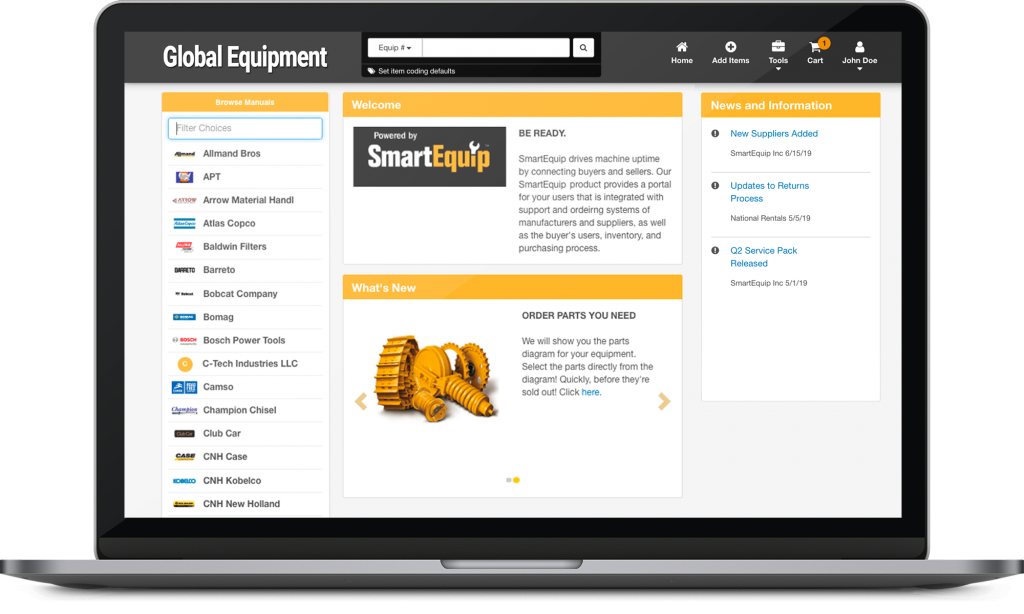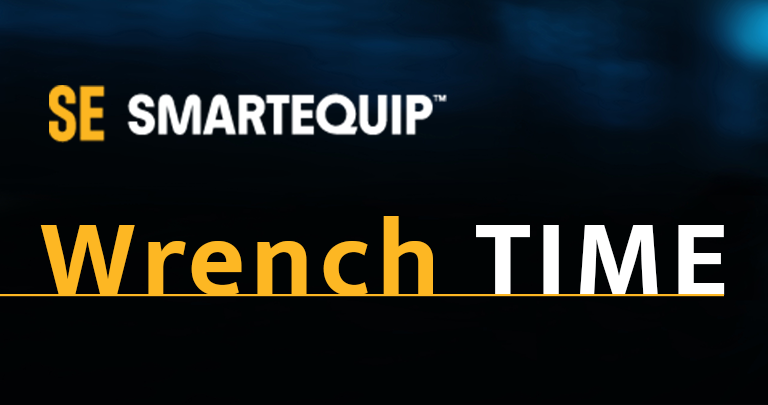Published by Verify Markets, July 22, 2020.
SmartEquip is the leading technology standard for equipment lifecycle management, service and procurement support for the construction industry. The platform provides a multi-brand common connection and user experience for fleet owners and distributors of complex equipment. SmartEquip enhances ROI for all Network participants by increasing equipment uptime, improving both technician wrench time and transaction accuracy, while reducing the total cost of equipment ownership.
The SmartEquip Network currently supports more than 500 OEM brands, with over 50,000 users across more than 4,000 equipment locations globally. The Network supports over $1 billion in parts transactions annually and the company is led by veterans of construction, technology and data sciences. Founded in 2000, SmartEquip is positioned to define tomorrow’s dynamic and evolving equipment industry. Dr. Alexander A. Schuessler is the founder of SmartEquip and president of its International Group. He is also a member of the technology committee of the European Rental Association.
Could you please provide a brief history and overview of SmartEquip?
I started SmartEquip in early 2000 after co-founding a company called Caterpillar Rental Services Network, Inc. in 1994. My partners were industry veterans who had recognized early in their careers that the future in the use of construction and industrial equipment was going to be to rent rather than own it. We helped Caterpillar enter the equipment rental market, initially in South America, and then a number of other parts of the world. During that time, my interest specifically turned to “lifecycle management” of such equipment – the service, parts, maintenance side of the business, which is especially complicated and costly when you operate machines from dozens if not hundreds of different suppliers, requiring parts and service to keep them running. Over the past 20 years, SmartEquip has grown an electronic Network linking manufacturers, dealers, and owners of equipment fleets worldwide in real-time, providing intelligent, asset-specific parts and service support, resulting in both significantly lower operating costs and higher machine availability.
Could you please tell us some of the strengths of SmartEquip?
We are unique in that we do not focus on the different silos of equipment ownership – meaning equipment purchase versus equipment repair and service, versus parts purchasing, versus parts inventory and stocking, etc. Instead, we cover the entire equipment lifecycle, which means we cover all of these segments “horizontally” – from “cradle to grave”. We are not just a procurement solution and not just an e-commerce or sourcing solution. Instead, we embed the transactional side within the maintenance, repair, and service side.
What is the value proposition of the organization?
There is impact at both the top and the bottom line because our technology reduces fleet owners’ costs of owning assets while also increasing their returns on those assets. We make it less expensive to service equipment by making service technicians considerably more efficient. In addition, we also reduce the cost burden on the back office by reducing administrative costs in finance and data management associated with supporting both purchasing and field service, thus enabling the organization as a whole to save money. On the revenue side, we reduce equipment downtime, resulting in a higher return on asset. For our customers who are contractors, it means they can get more work done with the same number of machines, and for those who are equipment rental companies, they can get higher revenue out of their existing fleet.
How do SmartEquip solutions differ from the competition?
We invented the technology because we came out of the equipment industry rather than create a solution and then look for applications. That was a challenge because within the tech landscape of 2000 (when we started the company), it required us to build the solution from ground up, using cutting-edge high technology. We wrote every line of code (there were no “objects”) and built our own data centers (there was no cloud). We were driven by our understanding of key performance indicators, such as the financial utilization of fleets, the labor cost burden on work orders, etc., and to the present day, everything we do is focused on improving these vital metrics for the user. This also means our target customers understand the impact of our technology from a business perspective, since we naturally speak the same language, and we partner up together to look for continuous improvement once they are on our Network. It’s a rewarding journey we take together.
What is the geographic scope of your services?
There are approximately 100 equipment fleet owners using our technology and over 1,000 suppliers who receive orders via our Network globally. More than half of these suppliers are customers of ours, which allows them to receive a slew of additional operational benefits. Measured in terms of rental revenue, in North America today we support more than 70% of the activity of the top 20 equipment rental companies, and 60% of the top 100 rental companies. So, we are the industry standard there. Over the past 6-7 years, my primary focus has been on expanding our footprint globally. Just under half of the global $150 billion rental industry is in North America, and the rest is mostly split up between Europe and the Asia Pacific Rim (APAC) – so our focus has been on Europe (where we are also approaching the industry standard), as well as Japan and Australia, as the Northern- and Southern-most anchors of APAC, respectively. In total, we now actively support well over half the activity of the world’s top 25 rental companies (also measured by revenue) and expect for that level to reach 85% in the next 18 months. Our international growth excites us tremendously, and it is one of the things I am personally most passionate about.
What are the main problems that equipment rental companies encounter with parts purchasing and management and how is SmartEquip helping them?
When your fleet contains equipment from dozens or even hundreds of suppliers, it becomes nearly impossible to handle always-changing parts and service information covering thousands of different model constellations and configurations across several hundred equipment depots or jobsites. It takes service technicians a long time to locate the right parts for the right serial number of a particular model from one of the many makes – especially as every manufacturer handles technical support information differently. We allow these suppliers electronically to push the always current, always correct serial-number-specific information into the workflow of each service technician by connecting either their own or their dealers’ systems with those of their customers. Technicians then no longer need to go out and find the information, but it comes and finds them, right when it is needed, on their mobile device, keyed to the unique asset number of the machine they are repairing. That reduces service time, parts searching time, and virtually eliminates all associated errors. Technicians love it because it eliminates the administrative work requirements (the system automatically creates their work orders, purchase requisitions, and purchase orders, in addition to auto-delivering their technical information to each serial number). Remember, none of them chose their profession because they enjoyed paperwork. Our technology allows them to focus on what they love most – taking care of machines.
One of the main challenges that the equipment rental industry is currently facing is to find qualified workers. How is SmartEquip helping them to overcome this challenge?
That’s a great question – we help in two ways. First, by empowering the service technicians to near-double their output, we help to directly reduce the pressure created by this labor shortage. The very first version of our application approximately 15 years ago was able to reclaim technician “wrench time” by removing approximately 580 hours of information search and data input requirements from the typical technician’s 2,000-hour work year. Today, that number has increased to almost 1,000 hours.
Second, we often hear that the technology has modernized the service technician’s experience – they love what they do because they now have high-tech tools at their disposal, and we very much like the thought that we can continue to help make this line of work compelling.
Who are your main clients and how has SmartEquip solutions impacted their productivity and profits?
Our clients range from the largest rental companies in the world, like United Rentals, to small five-location family operations. They all see decreases in labor cost for both service technicians and the back office, and they all see improvements in fleet availability and, thus, revenue. The difference is that in a large company, SmartEquip allows you to reduce the size of their Accounts Payable (AP) group because we have reduced pricing errors on orders. In a small company where the degree of labor specialization is much lower and everyone wears several hats, we may reduce the amount of time the service manager needs to spend on the phone to fix AP-type problems. But, the underlying efficiency gains are the same.
How many part suppliers do you currently have in your network?
We have over 500 suppliers subscribing to use the Network, and then there are another 500 suppliers who receive email orders from fleets using SmartEquip technology but who have not yet signed up as full Network participants.
Where do you see yourselves positioned in this future?
We will continue to grow internationally, continue our expansion into contractor markets, and continue to be utterly maniacal about improving operating efficiency for suppliers and fleet owners alike.
Where is the company concentrating its R&D efforts?
Because we are integrated in so many systems, we have a spectacular view of each maintenance, service, and repair situation. There is a lot of value in the data that is being generated, and we are starting to explore partnerships with AI and big data companies specializing in the machine space, initially to create analytical insights for fleet owners and suppliers with regard to equipment performance, and ultimately to predict machine failure before it happens. There are some giants in the field who would love to run their methods on our data, and we are learning in our discussions with them that there are tremendous partnerships to be had. To me, that is the revolution we’ve all dreamed about for a long time, and now it’s here.
What are going to be some of the major trends affecting the parts procurement and maintenance services in the equipment rental industry?
Machines ultimately will no longer fail because we will learn to predict, and subsequently avoid, their failure through preemptive, optimally devised action. Parts suppliers increasingly will ship parts in anticipation of this failure and not charge the equipment owner until that part is being pulled off the customer’s own shelf and installed in the machine, thus avoiding equipment failure. This type of world is much closer than people realize, and it is enabled by combining the equipment lifecycle and transactional Network we were able to embed across global fleets with the powerful inferential capabilities of modern data sciences. It is a very exciting world.




